Carolinians on Guam
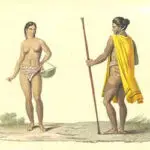
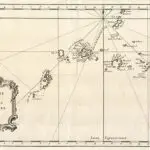
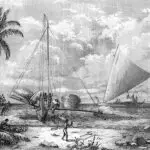
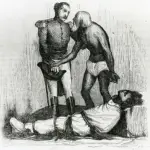
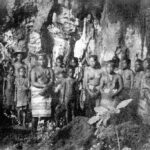
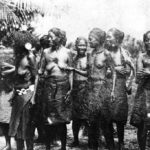
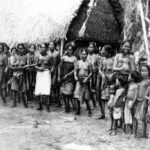
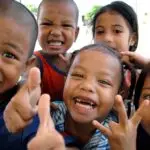
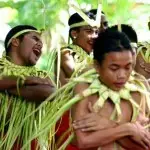
Table of Contents
Share This
Historical relationship
Peoples from the Caroline Islands have had a lengthy pre-contact history with the Mariana Islands. Research into indigenous Pacific voyaging overall shows indigenous movements throughout the Pacific, thus making centuries of Carolinian voyaging contact with the Mariana Islands – and CHamoru/Chamorro voyaging contact with the Caroline Islands a certainty.
There is archaeological evidence of early Carolinian-CHamoru contact embodied in several “pre-European contact” Carolinian designed pestles, fish hooks, and shell rings found above and below ground in the Mariana Islands. There is also the logical inference of CHamoru awareness of other peoples in the world despite the CHamoru traditional creation story that centers the origins of all human life upon Guam.
Some of these people, after leaving the Marianas for other lands, eventually returned but jabbered as lunatics who had forgotten their language, according to the CHamorus. Father Diego Luís de San Vitores doubted Antonio Pigafetta’s assertion, as part of the Ferdinand Magellan expedition, that the CHamorus believed they were the only people in the world because the epistemological aftermath of the CHamoru creation story clearly indicated that CHamorus were aware of other peoples before European contact.
CHamoru traditions also spoke of earlier migrations from the south and west which early Spaniards linked with the 1686 chance Spanish arrival at either Ulithi, Yap, or Fais which they called “La Carolina” that these Spanish also indeed described as being to the south and west of Guam. La Carolina was eventually to become the name basis for much of Micronesia itself that is still used today.
Spanish Era
Early Spanish commander José de Quiroga, aware of the escape by CHamorus to these southern islands following Spanish assaults against rebellious CHamorus and their villages, and encouraged by Spanish priests set on saving indigenous souls, sent out an expedition to find La Carolina. With CHamoru Alonzo Soon accompanying the well manned and provisioned expedition, the Spanish ultimately failed to find it despite extensive searching. Some scholars speculate that Soon could have led the Spanish off-track and thus away from La Carolina and the CHamorus living there.
This failure kept Spaniards ignorant of the Caroline Islands until Carolinian voyagers driven off course by storms were first detected in the Southern Philippines in 1696.Father Paul Clain (or Klein) endeavored to learn as much as he could about them. On 10 June 1697, Father Clain sent a descriptive letter about them from Manila to the General of the Order of Jesus in which he noted that the Carolinians described their “country” as containing 30 islands. Among them was Saipan (“Saypen”) in the northern Mariana Islands. Father Clain wrote:
They cannot be very far from the Marianas, to judge from the structure of their vessels, and by the form of their sails, since these are of the same style . . . . Their language is different from that of the Philippines, and resembles that of the Mariana Islands.
In June 1721, two canoes apparently drifted from Woleai in the central Caroline Islands and landed on Guam, one at Talo’fo’fo Bay on the east side of Guam and the second at Orote Point on the west side, within days of each other. The first canoe, with 24 people, had its sail so high that the Spanish initially feared it was an English frigate, conjuring up memories of the visit by British pirate John Clipperton a month earlier. Father Juan Antonio Cantova wrote a report on these Carolinians, providing probably the first written details of them. He observed that the first canoe was “little different from the CHamoru boat, but higher so that at full sail it was mistaken for a frigate.”
Father Cantova speculated that once the Caroline Islands were found and missionary endeavors took hold there, Carolinians themselves would return to the Mariana Islands “once the harvest were [sic] ripe” to “look for harvesters and would guide them to their homes, which our own efforts had not revealed to us.”
Although these Carolinians soon grew homesick and wanted to sail home, Governor Luís Antonio Sánchez de Tagle decided to dispatch some of them by the month of October, to carry the news back to their islands, and to invite their residents to undertake a trade with these Marianas with the attraction of iron, and until they returned [to Guam], to detain some chiefs in the group as hostages.
However by October navigation becomes difficult in this area of the Pacific. Governor Tagle’s plan was to delay their return until the next spring when they would be better prepared.
According to an anonymous written epilogue, three CHamoru canoes “with four men in each” were added to this planned voyage and left Guam on 15 April 1722 to the “numberless Austral Islands” along with a small patache with “14 men, Spanish and Filipinos, with their officer” and Father Cantova who had begged his superior to be included so as to begin the Christian conversion of the Caroline Islands.
After 10 days of strong currents and winds which pushed the patache to the Cape of San Bernardino on the island of Luzon in the Philippines:
the smaller CHamoru canoes were badly battered and two of them were forced to turn back, but the rest of the fleet pursued their voyage.
The third CHamoru canoe returned to Guam about a month later on 26 May.
It had taken 10 days to make it back,” the author continues, “by some miracle they say, and indeed it was miraculous because they were without a magnetic compass and guided themselves only by the stars.
It is probable that after the Spanish reduccion commenced, Carolinians gave Guam and its new Spanish masters a wide berth and that the chance landings of the two Woleai canoes on Guam were not intentional voyages to the Mariana Islands. Although there are a few other recorded voyagers to Guam such as the two Carolinians who drifted in as sole survivors in 1756 and 1757 and were used by Spanish officials as translators, the Spanish rule of the Marianas combined with an apparent concern for impending Spanish revenge for the 1731 killing of Father Cantova and others at the fledgling mission on Ulithi, contributed to the Carolinian avoidance of the Mariana Islands until 1787.
In that year, a canoe fleet led by Lamotrek navigator Luito arrived at Talo’fo’fo Bay after fears of Spanish retribution for Father Cantova’s martyrdom at Ulithi and the overall desire to avoid the Spaniards had apparently been assuaged by a greater desire to trade for coveted pieces of iron.
Luís de Torres takes interest
CHamoru sargento mayor Luís de Torres took a great interest in these voyagers, befriending them to the extent that the Carolinians promised Torres they would return the following year and begin regular trading relations between the Caroline Islands and Guam. On its return voyage however, a severe storm destroyed the entire fleet at sea. Those awaiting the fleet in the Caroline Islands may have surmised that the voyagers had either been imprisoned or murdered by the Spanish or CHamorus on Guam.
Torres waited until 1804 before organizing a humanitarian laden voyage on shipmaster Samuel W. Boll’s schooner and supercargo Thomas Borman to Woleai to determine why the Carolinians had not returned to Guam and to convince them to start trading again. Torres brought along previous Carolinian castaways, livestock, an Englishman and a forge with which the Englishman planned to teach the Carolinians the art of blacksmithing. The Englishman died, however, as eventually did the plants that could not flourish in the soil of the atoll. The livestock were eaten.
Torres was able, however, to greet the Carolinians in their own language and, as he had in 1787, befriended them. Torres reassured the islanders that their comrades had not been murdered or imprisoned on Guam and convinced them to begin voyaging to Guam again – the location of which had always existed in traditional navigational chants. The Carolinians subsequently began voyaging contact with the Mariana Islands again in 1805.
As a result of this expedition and his well-known camaraderie with and helpfulness toward the Carolinians, Torres became implanted in traditional Carolinian songs (he was referred to as “Louis”) along with Borman (known as “Marmol”). Torres and Borman were evidently still being remembered when explorer Otto von Kotzebue’s Woleaian friend Kadu spoke of Torres in relation to Woleai’s connections with Guam in November 1817. According to Kotzebue, the songs were composed so that the men might not be forgotten.
Since this time, 18 canoes assemble every year at the island-group of Lamureck [Lamotrek], thence they sail to Fojo [probably West Fayu] (a desert island, according to the description, lying to the north of Lamureck,) which they reach in two days, rest there, and then the fleet sails in three days to Guahon [Guam]).
Explorer Otto von Kotzebue
Torres became an important source of information on the Carolinians for early 19th century explorers from France, Russia, and Germany including Kotzebue, Santiago Arago and Louis Claude de Freycinet, Adelbert von Chamisso, and Ferdinand P. von Lütke. Serving then as Governor José Medinilla y Pineda’s deputy, Torres provided these explorers with extensive information on the Carolinians, their language, and the Caroline Islands. Chamisso had also benefited from his previous several months acquaintance with Kadu on Woleai, using that experience to ask questions of Torres on issues such as the historic links between Guam and the Caroline Islands and the overall navigational and trade endeavors of the Carolinians.
More than any other explorer, Chamisso, the Renaissance man effectively conveyed his extensive notes and conjectures on the Carolinians to a European audience. In 1819, under an agreement authorized by officials in Manila, Governor Medinilla found a settlement for Carolinians on Saipan, an island that had been uninhabited since the Spanish conquest of the Marianas. He agree they could stay there with the conditions that they accept Christianity and live at peace with the Spaniards and the CHamorus. The settlement grew over the next few decades. Visitors to Saipan noted, however, that cultural changes were occurring under Spanish influence.
In 1819, Freycinet also observed voyagers from Satawal performing a “stick dance . . . duly performed with perfect precision” in Hagåtña and noted that these Satawalese had transported observers to Rota and Tinian and had then left Guam to sail back to Satawal. Freycinet’s wife Rose referred to the canoes as charming and was taken part of the way on one of the canoes during an expedition to Rota and Tinian led by the navigator Ouamataou.
Freycinet also gleaned information from these Carolinian voyagers on sequences of constellations used in a voyage from Satawal to Guam, the division of the horizon into four cardinal sectors, the intricacies of palm leaf knot divination to determine the fate of a voyage, and the use of a star compass composed of “24 little slices.” The regularity and elegance of their blue and black tattoos reminded Freycinet of “those striped stockings that were worn in France at one time.”
Lütke emphasized negative aspects of Spanish influence among the Carolinians, observing in 1835 that Carolinians in the Mariana Islands were “to their free countrymen as a caged parrot is to the magnificent flocks that enchant the traveler in the forest” and that behavior such as begrudging hospitality, demands, and theft had suddenly begun to appear on Woleai and other Caroline atolls.
In the mid-1830s, severe typhoons compelled about sixty Carolinians to voyage to Guam. They were allotted land on Saipan upon which the survivors settled. At about this same time, “lepers” were sent by Governor Francisco Ramón de Villalobos from the “hospital for lepers” at Adelup on Guam to Saipan where concern soon arose over the impact that the Carolinians would have upon available meat from wild pigs and cattle on Tinian and Saipan that were intended for consumption by the “lepers” as had been the practice in the past.
There apparently was little intermingling between Carolinians and CHamorus on Saipan with the Carolinian community, rather than initially spreading across Saipan, preferred to congregate on Saipan’s western slope where the village of Garapan emerged. In 1851, Lieutenant Governor Juan Ruíz Roda recommended that the 300 Carolinians on Saipan be moved to Tamuning on Guam because of the lack of a priest on Saipan. He envisioned that the priest of Hagåtña could gradually convert them. And subsequently, “having been converted, they would form unions with the natives [CHamorus] who, in general, treat them very well. “
While officials charged that some Carolinians sailed back to the Caroline Islands because they did not want to be obligated to cultivate land for their subsistence, Spanish officials in Manila also objected to this unauthorized granting of land and advised that the Carolinians be transferred to the central Guam village of Hagåtña where they could be better controlled so that “by conserving their semi-savage customs, they would [not] be detrimental” to the National Treasury.
On 25 January 1849, one of the strongest earthquakes in Guam’s history prompted tsunami waves in the Caroline Islands which swamped at least four atolls and also compelled numerous Carolinians, particularly from Satawal and Lamotrek, to voyage to Guam and to join their relatives on Saipan. According to Governor Pablo Pérez (1848-1855), it was
a flood that caused the islands to disappear for several hours, destroying all plantings and most of the trees.
The first canoe of survivors reached Hagåtña with eight people from Satawal. Two more canoes arrived the next day with 41 men, women, and children. Governor Pérez counted 10 men and 15 women in the first canoe and 10 men and six women in the canoe, all weak from hunger and in miserable condition after having spent many days without food.
While Nicolás Saavedra, a government official in Manila, had already pushed for the recruitment of Chinese interior farmers to settle in the Marianas so as to increase its population and promote agricultural production, Governor Felipe María de la Corte (1855-1866) seriously considered a scheme to mix Chinese with Carolinians, following the devastating 1856 smallpox epidemic on Guam which killed half of the population, so as to create a race that would be more resilient to disease.
Other officials believed however that the perceived “shrewdness” of Chinese immigrants would put at peril the “inborn, docile, believing, and honest instincts characteristic of the people of all these islands.” Corte instead promoted the regular use of a ship to keep up regular communications with the Caroline Islands and to assist with “voluntary migration.”
In 1866, entrepreneur and George H. Johnston transported nearly 1,000 Carolinians to the northern Mariana Islands (although some settled on Guam) to work on agricultural projects – particularly cotton and a cattle ranch on Tinian. Some of the 600 Carolinians who had also arrived around 1861 on labor contracts were living on Guam. Johnston also leased the islands of Agrihan, Tinian, and Pagan in 1869 (Spanish authorities were concerned that other countries might otherwise claim these unpopulated islands) for his ventures which, however, eventually suffered when Carolinians abandoned a cotton harvest because of unfulfilled payment promises made to them by Johnston’s Agricultural Society la Concepción.
An agreement was eventually reached between Spanish officials and the Society in which selected Carolinians would complete the harvest and collect the debt. More than 400 Carolinians from among the 604 islanders recruited from Namonuito atoll by Johnston in 1867 were resettled from Saipan to Tamuning on Guam after a September 1868 typhoon. Johnston was lost at sea on 14 October 1876 along with 10 Carolinians. Although his wife tried to manage Johnston’s business – apparently hoping that he would suddenly turn up – the Spanish government terminated Johnston’s leases in June 1877.
By 1884, Governor Angel de Pazos y Vela-Hidalgo was exuberant over the creation of the Carolinian barrio of Maria Cristina within the Hagåtña district but was assassinated that same year by one of his CHamoru guards, José de Salas in front of the governor’s Palacio in Hagåtña as part of an unrealized plan to seize control of the government. Governor Luís Santos Fontordera (1891-1892) requested permission from his Manila superiors to close the Maria Cristina barrio and bring Carolinians into Hagåtña itself where their assimilation into the general populace could be hastened. He argued that these Carolinians, as decedents of Carolinians who had settled decades earlier on Guam, would not only be able to remove themselves from a level of civilization little different from when they first arrived, they could also avoid being enslaved by the people of the islands where they go, as has been customary.
Hidalgo’s successor, Governor Francisco Olive y García (1884-1885) had however wanted to move the Maria Cristina Carolinians as well as Carolinians on Rota to Saipan because of large areas of uninhabited, farmable land there.
Peoples of the Caroline Islands had formed a community in the area of present day Tamuning as early as 1816 that was added to significantly in 1849. Tamuning could have actually been derived from a Carolinian chief’s clan name although Tamuning was also periodically referred to as Maria Christina during the 19th century.
Reports from past Spanish governors (1828-1852) commissioned by the Governor General of the Philippines, Antonio de Urbistondo for the benefit of Governor Felipe María de la Corte y Ruano Calderón (1855-1866), noted that six to eight Carolinian bancas (a style of boat) typically arrived at Guam during the month of April. In exchange for tools, jars, pieces of iron, and other items from CHamorus, these Carolinian voyagers brought seashells, cordage, and “little canoe-like receptacles that are used . . . as tubs for washing the feet.”
US Naval Era
Although former governor Robert E. Coontz (1912-1913) wrote in his memoir (1930) that the first American governor of Guam, Richard P. Leary (1899-1900), issued Order No. 2 that required Carolinian women in the village of Sinajana to cover their nakedness whenever Leary visited, only General Order No. 21 addressed Carolinian nakedness and did not refer to Sinajana:
The males of the Caroline islanders’ community in Guam are hereby forbidden to appear in public in their customary nude condition or “string-and-pouch” decoration after the 30th day of this month, by which date they must provide themselves with suitable conventional wearing apparel.
General Order No. 62, issued on 26 September 1903 by Governor William E. Sewell (1903-1904) rescinded this order.
The continued state of nudity of the Carolinians so incensed the second American governor, Seaton Schroeder (1900-1903), that he deported them in 1901 to Saipan through agreement with German authorities of the northern Mariana Islands who welcomed the additional laborers, with or without clothes.
According to Beers, most perturbing to Schroeder was the practice of visitors to Guam “rush[ing] out to the Caroline Islanders’ village” to take pictures of them in this state of nudity and then returning to the US mainland where they depicted these Carolinians as Guam ladies, much to the chagrin of the real CHamorus.
Post World War II
By the time that Robert R. Solenberger conducted his 1953 study on the “Social and Cultural Position of Micronesian Minorities on Guam” for the South Pacific Commission, he recorded the existence of less than 150 Carolinians on Guam.
Because of the lengthier and more substantial settlement endeavors of Carolinians in the northern Mariana Islands and the different political status of the Commonwealth of the Northern Mariana Islands from that of the US territory of Guam, both Carolinians and CHamorus are considered indigenous to the Northern Mariana Islands and can own land while non-indigenous individuals can only lease it.
The transformation, however, of the US Trust Territory of the Pacific Islands (1947-1986) into the Commonwealth of the Northern Mariana Islands, The Federated States of Micronesia (composed of Chuuk, Pohnpei, Kosrae, and Yap states), the Republic of the Marshall Islands, and the Republic of Palau included the right for these peoples, through a Compact of Free Association, to travel to and reside in the United States (including Guam and the Northern Marianas) unhindered. This has since led to a substantial increase of Carolinians on Guam with approximately 11,000 Carolinians/Micronesians recorded as residing on Guam during the 2000 US census.
For further reading
Bassett, Marnie. Realms and Islands: The World Voyage of Rose de Freycinet in the Corvette Urainie, 1817-1820. London: Oxford University Press, 1962.
Carolinians in the Marianas in the 1800s: Selected Documents from the Holdings of the Spanish Document Collection at the Micronesian Area Research Center. Translated and edited by Marjorie G. Driver and Omaira Brunal-Perry. Saipan and Mangilao: Commonwealth of the Northern Mariana Islands Division of Historic Preservation and Micronesian Area Research Center, University of Guam, 1996.
Commonwealth of the Northern Mariana Islands Division of Historic Preservation. Carolinean Contacts with the Islands of the Marianas: The European Record. By Glynn Barratt. The Micronesian Archaeological Survey No 25. Saipan: HPO, 1988.
Coontz, Robert E. From the Mississippi to the Sea. Pittsburgh: Dorrance & Company, Inc., 1930.
Desgraz, César. The Guam Narrative of Cesar Degraz. Translated by Robert D. Craig. Hagåtña: Nieves M. Flores Memorial Library, 1984.
Farrell, Don A. The Pictorial History of Guam: The Americanization 1898-1918. 2nd ed. Tamuning: Micronesian Productions, 1986.
Freycinet, Louis Claude de Saulces de. An Account of the Corvette L’Uraine’s Sojourn at the Mariana Islands, 1819. Translated by Glynn Barratt. Saipan: Commonwealth of the Northern Mariana Islands Division of Historic Preservation, 2003.
García, Francisco Olive y. The Mariana Islands, 1884-1887: Random Notes. 2nd ed. Translated and annotated by Marjorie G. Driver. Mangilao: Micronesian Area Research Center, University of Guam, 1984.
Hezel, Francis X., SJ. The First Taint of Civilization: A History of the Caroline and Marshall Islands in Pre-Colonial Days, 1521-1885. Honolulu: University of Hawai’i Press, 1983.
Lander, James F., Lowell S. Whiteside, and Paul Hattori. “The Tsunami History of Guam: 1849-1993.” Science of Tsunami Hazards 20, no. 3 (2002): 158-174.
Levin, Michael J. “A Brief History of the Population of Guam from 1710 through 1897.” In Guam History: Perspectives. Volume Two. Edited by Lee D. Carter, William L. Wuerch, and Rosa Roberto Carter. Mangilao: Richard F. Taitano Micronesian Area Research Center, University of Guam, 2005.
Sanchez, Pedro C. Guahan Guam: The History of Our Island. Hagåtña: Sanchez Publishing House, 1987.
Santa María, Gregorio de. Reports Concerning the Mariana Islands: The Memorias of 1844-1852. Edited by Marjorie G. Driver and Omaira Brunal-Perry. MARC Educational Series no. 21. Mangilao: Micronesian Area Research Center, University of Guam, 1996.
US Navy Department Office of Records Administration. American Naval Occupation and Government of Guam, 1898-1902. By Henry P. Beers. Washington, DC: DONRA,1944.
